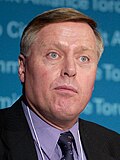
Back Élections générales ontariennes de 2007 French 2007 Ontario general election SIMPLE 2007年安大略省大選 Chinese
| |||||||||||||||||||||||||||||||||||||||||||||||||||||||||||||||||||||||||||||||||||
107 seats in the 39th Legislative Assembly of Ontario 54 seats were needed for a majority | |||||||||||||||||||||||||||||||||||||||||||||||||||||||||||||||||||||||||||||||||||
|---|---|---|---|---|---|---|---|---|---|---|---|---|---|---|---|---|---|---|---|---|---|---|---|---|---|---|---|---|---|---|---|---|---|---|---|---|---|---|---|---|---|---|---|---|---|---|---|---|---|---|---|---|---|---|---|---|---|---|---|---|---|---|---|---|---|---|---|---|---|---|---|---|---|---|---|---|---|---|---|---|---|---|---|
| Turnout | 52.8% | ||||||||||||||||||||||||||||||||||||||||||||||||||||||||||||||||||||||||||||||||||
| |||||||||||||||||||||||||||||||||||||||||||||||||||||||||||||||||||||||||||||||||||
 Popular vote by riding. As this is an FPTP election, seat totals are not determined by popular vote, but instead via results by each riding. Riding names are listed at the bottom. | |||||||||||||||||||||||||||||||||||||||||||||||||||||||||||||||||||||||||||||||||||
| |||||||||||||||||||||||||||||||||||||||||||||||||||||||||||||||||||||||||||||||||||
The 2007 Ontario general election was held on October 10, 2007, to elect members (MPPs) of the 39th Legislative Assembly of the Province of Ontario, Canada. The Liberals under Premier Dalton McGuinty won the election with a majority government, winning 71 out of a possible 107 seats with 42.2% of the popular vote. The election saw the third-lowest voter turnout in Ontario provincial elections, setting a then record for the lowest voter turnout with 52.8% of people who were eligible voted. This broke the previous record of 54.7% in the 1923 election,[1] but would end up being surpassed in the 2011 and 2022 elections.
As a result of legislation passed by the Legislature in 2004, election dates are now fixed by formula so that an election is held approximately four years after the previous election, unless the government is defeated by a vote of "no confidence" in the Legislature. Previously, the governing party had considerable flexibility to determine the date of an election anywhere up to five years of being elected. The date of this election was originally presumed to be October 4, 2007;[2] however, the law fixes the date on the first Thursday of October or on any day within seven days thereof if required to accommodate a date of "religious or cultural significance". The date was set as October 10, 2007, to avoid a conflict with the Jewish holiday of Shemini Atzeret, which fell on October 4, 2007.[2]
In the same election, there was a provincial referendum on whether to change from first-past-the-post to mixed member proportional representation, as recommended by the Ontario Citizens' Assembly on Electoral Reform. This measure failed, with 37% of the participating electorate and 5 out of 107 ridings voting for the new system; a 60% supermajority was required province-wide, with at least 2/3 of the ridings also supporting it by a simple majority.[3]
Cite error: There are <ref group=lower-alpha> tags or {{efn}} templates on this page, but the references will not show without a {{reflist|group=lower-alpha}} template or {{notelist}} template (see the help page).
- ^ "Boring campaign behind poor voter turnout: analysts". CTV News. Toronto. October 11, 2007. Archived from the original on May 29, 2014. Retrieved May 28, 2014.
- ^ a b Howlett, Karen (February 7, 2007). "Ontario government changes election date". Toronto: The Globe and Mail Newspaper. pp. Online update. Archived from the original on June 5, 2014. Retrieved May 28, 2014.
- ^ "Electoral System Referendum Act, 2007, S.O. 2007, c. 1 - Bill 155". July 24, 2014.



